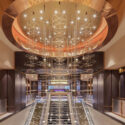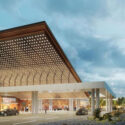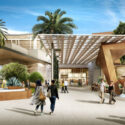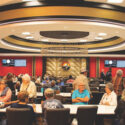
If you own a casino today, you are painfully aware that the recent recession has resulted in lower visitor counts, reduced occupancy rates in guestrooms, and ultimately, reduced revenue. Some properties have reduced room rates to attract more business, and several properties have shuttered parts of their facilities to reduce operating costs.
Many have put off expansion plans, some going as far as stopping work on projects until the economy improves. Others have focused their new work in overseas markets such as Macau, where the recession has only slowed the rate of growth.
The recession, however, has not ended business—it’s just slowed it down. Through fat or lean, a lot of business activity has still gone on—certainly less now than in the previous fat times, but in both fat and lean economies, casinos still have guests, the bars and restaurants have patrons, and the guest rooms get used. Over time they all need maintenance; over time they all get to the point where they need to be refreshed.
In the lean times, the question is how much money can we spend on capital improvements, and where is the best place to spend that money?
We asked that question of a number of leaders in the casino industry—owners, contractors, and design professionals such as architects and engineers, and asked them where best to spend a hypothetical $50 million in capital improvements.
Now, the $50 million figure was used as representative of a small capital improvement budget, one that reflected the lean times of the business cycle as opposed to the $200 million budgets of years past. We understand that for some properties, $50 million is a large budget at any time—but the answers we gathered will be useful for any property at any time, fat or lean, large or small.
Priorities for Improvements
Of course, the point in any capital improvement is to drive up the visitor count. Recapture those customers who have gone elsewhere seeking a new experience, and bring in people who have never been to the property. For recaptures, the key is to have them see the improvements as they arrive, and make them curious about what else may have changed.
Joel Bergman, president of Bergman Walls & Associates, sums it up neatly with a short list of priorities: “Generally, the porte cochere/entry is the first physical building element a guest experiences upon arrival at a property. Spending a few dollars to enhance the appearance will create a new sense of excitement. Similarly, making over the gaming floor is an impactful experience for the guest. Secondarily, dining venues, lounges and bars, and lastly, guestroom improvements and additions fall into the spending spectrum.”
This follows the logic that the greatest portion of visitors to a casino will be on the gaming floor, but may also then visit the restaurants and bars along with customers that come only to dine. The smallest quantity of visitors will be those who also stay in the guestrooms overnight.
Points of Entry
For many properties, the point of entry is in a parking structure. Many guests prefer to self-park over valet parking, and many will use the parking structure because it’s closer to the casino and provides protection against the weather. Whatever the reason, the parking structure then becomes the entry point for the guest, and thus their first experience with the property.
Paul Keller, senior vice president and chief development officer of Isle of Capri Casinos, emphasizes the need to improve the “touch points” of the guest experience. This includes keeping the parking structure in good order.
“Re-striping the parking lot and a really good power wash gives the patron a sense of cleanliness at the ‘front door’ for all self-parkers,” says Keller. “That has a positive intangible impact.”
The value of good lighting for a customer’s sense of security and clear way-finding is also noted by Brett Ewing, partner at Thalden Boyd Emery Architects, and Bob Dollar, vice president of Friedmutter Group Architects.
Gaming Floor
Beyond the point of entry, the gaming floor is the main attraction for most of the visitors to a casino. It is also one of the hardest areas to upgrade, given that it is in service around the clock. However, simple upgrades with minimal disruption are available. Keller says a small budget can make a big impact in the gaming floor, noting that the emphasis needs to be placed on a customer’s “touch points”—literally.
“On the gaming floor, aside from the gaming product, there are few things that customers care about more than the chairs,” Keller says. “So, making sure those have good cushions and new fabric can make a big impact for very little money.”
Dollar suggests that cosmetics can also go a long way.
“Changing the casino carpet can make a big impact on the property and can frequently be achieved relatively quickly and cost-effectively,” he says. “Changing the color or pattern of the carpet, or adding or deleting pathways in response to a property’s changes and gaming demands, can significantly enhance a property and the gaming environment.”
David Kruljac, business development director for Penta Building Group, notes that big impacts can be had by simply upgrading gaming equipment due to technology changes and changing guest circulation patterns.
Older facilities have often grown over time, and the gaming floor can appear as a more-or-less disjointed space that looks like a number of smaller spaces cobbled together.
Dike Bacon, principal and director of planning and development for Hnedak Bobo Group, says his firm is addressing such a problem at the Sycuan Casino near San Diego.
“Our casino has historically suffered from the ‘repetitive addition syndrome’ that has ultimately resulted in the casino feeling very piecemeal and closed off from one area to the next,” says Sheila Howe, general manager of Sycuan. “The renovation is being reconfigured to open lines of sight to create better way-finding, provide greater visibility, improve security and encourage customers into other revenue-generating areas of the two-story casino.”
In a similar situation, Bergman Walls gained “an extremely positive response” from the owner of a Midwestern casino to a unifying renovation design. “What was a series of dated, disjointed and disconnected spaces has become a dynamic, vibrant and attractive gaming environment,” says Bergman. “The exciting ‘new’ casino has changed and broadened the existing player pattern within the gaming floor, and has attracted new players as well.”
Another aspect to improving the guest experience on the gaming floor deals with overall comfort as determined by the indoor air quality. Smoking is permitted in most casinos, but a growing number of customers prefer to be in a non-smoking environment. Designating non-smoking areas is helpful to attract such customers, but providing improved ventilation systems that prevent the migration of secondhand smoke is also a big plus.
“The better the indoor air quality is within the casino space, the longer the guest will stay, resulting in more play and revenue,” says Greg Peterson, project manager at AE Associates. “Additionally, the guest is more likely to come back again to the property if they perceive the casino to be less ‘smoky’ than the competition down the street or in the next town.”
Restaurants, Bars and Lounges
Beyond the gaming floor, upgrades in restaurants, bars and lounges can also be effective draws under small renovation budgets. Keller points to an Isle of Capri property in Iowa that recently re-branded a fine dining restaurant. Changes involved paint, tabletops, artwork and menu changes. The cover count in the restaurant tripled, for a cost of $250,000.
“At the end of the day, people want the food to be good and priced right,” Keller says. “The menu and the execution of service becomes more important than the exotic back bar feature that cost $1 million.”
Of course, there are times when a major renovation needs to be done, when new menu items and tabletops are just not enough. Adding more seats to accommodate the growing number of casino guests may be necessary, or changing the atmosphere of both the venue and the gaming floor by opening each up to the other is an option.
Dollar of Friedmutter Group cites the example of Harrah’s Rincon Casino in Southern California, where two restaurants were recently renovated in response to increased competition and the need to freshen the venues. Dollar notes that “by creating ‘dual-view’ from within the restaurant out to the casino, and vice-versa, guests experience new excitement and energy from a variety of senses.”
Ewing of Thalden Boyd Emery adds that third-party venues should also receive some consideration in restaurant renovations, as they bring in new competitive brands, and the third party will often share in the development costs.
Guest Rooms
Guest rooms also need to be updated from time to time—every five to seven years, according to Ewing. Soft goods wear out and amenities need to be updated with current technology, and the need for replacement doesn’t always coincide with the best economic times. Flat-panel televisions are an example of a change driven by technology, and one day they may be replaced when 3D TV becomes more commercially viable. Beyond that, a good guest room can add a great deal to a property’s reputation and brand image.
Erik Fong, principal and project architect of MBA Architecture, says the guest will be impressed every time.
“Hotel guest room renovations can enhance a casino’s brand by elevating the level of luxury, adding amenities, or modernizing with new technology,” he says.
Fong also notes as an example a renovation to a 600-key hotel that included new finishes, furniture, lighting, and upgrades to plumbing, electronics and other furnishings for less than $10 million. And, one advantage guest room renovations have is minimal disruption to operations, as one floor of guest rooms is taken out of service for renovation while the other rooms remain available for guests.
Ancillary spaces in hotels can also be considered for renovation. For example, Fong explains that some meeting space at John Ascuaga’s Nugget in Sparks, Nevada, was renovated to improve lighting, finishes and indoor air quality. The improvements changed the nature of the space sufficiently to become a revenue-driver for the hotel, and the rooms are now actively marketed for small and medium-sized conferences, where before the space had been used only as a last resort.
Design Process
We also asked if the smaller budget made a difference in the design process itself. The answer was a resounding “no” among our respondents, with some qualifications.
Penta’s Kruljac noted that the smaller projects often had to work around existing layouts, structure and building systems—a much more challenging process than just gutting a space and starting from scratch. Consequently, more time is spent on the front (design) end with greater collaboration required between owners, designers and contractors.
Keller stresses the need for clear directions to the design team and quick owner feedback on design proposals, as design budgets, being smaller, do not allow for several iterations of the design.
Both Bergman and Fong note that smaller budgets often mean a more restrictive material palate and less latitude in finish materials and furniture selection. Fong also notes that alternate sources—less expensive products manufactured overseas, for example—often did not arrive with the promised level of q
uality.
Lean economic times may stay with us for a while, but the need to keep properties fresh and attractive remains. The budget for capital improvements may be smaller than in years past, which makes targeting improvements where they can make the biggest impact all the more important. Focusing on the important “touch points” of the entry points, gaming floor, restaurants and bars, and guestrooms will ensure that the property is not only improved, but seen as such by its visitors.
Small-budget projects, like their large-budget cousins, still need to have their scope well-defined, their costs determined, schedule established, communication pathways planned, and the work executed on time, on budget, and well-performed.
Thorough planning on the front end of a project, whether an entirely new ground-up facility or a relatively small renovation, can make a significant difference in how well everything comes together.

















